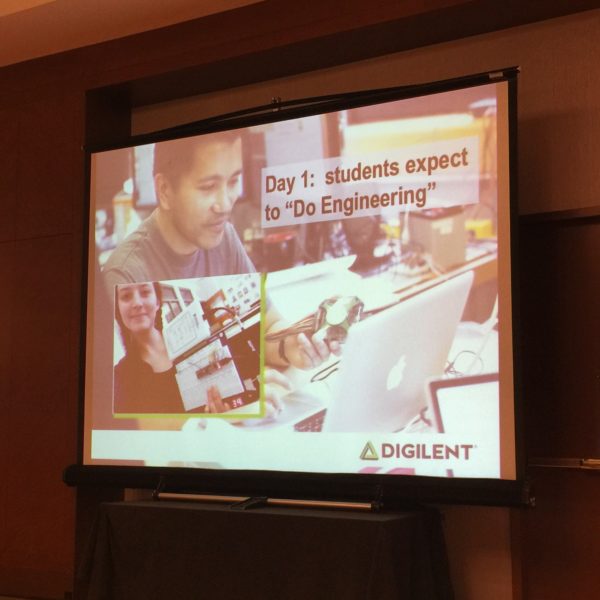Each year at the ECEDHA conference (Electrical and Computer Engineering Department Heads Association), the industry sponsors are given a 15 minute presentation slot called a “Spotlight Presentation.” It’s a great opportunity for us to deliver a message directly to the professors attending the conference. This year we decided to focus on student-owned instrumentation, and specifically on our Analog Discovery 2 product – a USB oscilloscope, logic analyzer, and all-in-one pocket instrument.

Digilent has always had an academic mission, and we are centered first on making better tools for teaching digital electronics. As we grew we expanded into microcontrollers and analog circuits, which led to our introduction of the original Analog Discovery in 2012.
In this year’s Spotlight Presentation, I asked the professors to imagine teaching another class of students with instruments – but not electronic instruments – musical instruments. What if we taught music the way that we teach engineering today? What if the students had to endure many semesters of music theory, math, and the physics of sound before ever playing a single note? What if their only exposure to an instrument was in a lab a few times a semester where they huddled around a shared instrument (probably old and dated) and each took a turn playing a few notes while the others watched? Sounds horrible right? But that’s a pretty good description of how engineering is taught today.
We know that many universities in the U.S. today are struggling to attract and retain engineering students. Many of these students come into their first year having participated in high school robotics programs. Some have played around with Arduino and Raspberry Pi boards. Through STEM programs like Project Lead the Way or MOOCs, some have even finished learning the fundamentals of digital electronics and programmed FPGAs! The expectations of today’s students is very different than just 10 years ago: they expect to do engineering from Day One.

At Digilent, we think that at least part of the answer to problem of enrollment and retention is student owned instruments like Analog Discovery 2. We think that every engineering student should start off their first year learning how to make measurements and how to correlate measurements to theory and simulations. Measurements are key to the engineering process. Instrumentation helps students visualize and make “real” what are often very abstract concepts – especially in electrical engineering where key concepts like voltage, current, resistance, and capacitance are invisible to the naked eye.
The great thing about a pocket-sized, multi-instrument like Analog Discovery is that it can be used from introductory engineering courses all the way through senior capstone design projects. It has applications in linear circuits (bode analyzer) to signals and systems (spectrum analyzer) to digital electronics and microcontroller courses (logic and protocol analyzers). At well under $200, it is less expensive than many textbooks. And, unlike a textbook, it is not limited to a single course.
At a time when engineering department heads are looking for ideas to help keep their students interested and engaged, we can’t think of a better way than making sure that each student has the ability to be an engineer from day one. An instrument like Analog Discovery is required equipment for doing engineering, just as a cello is required equipment for becoming a cellist.

